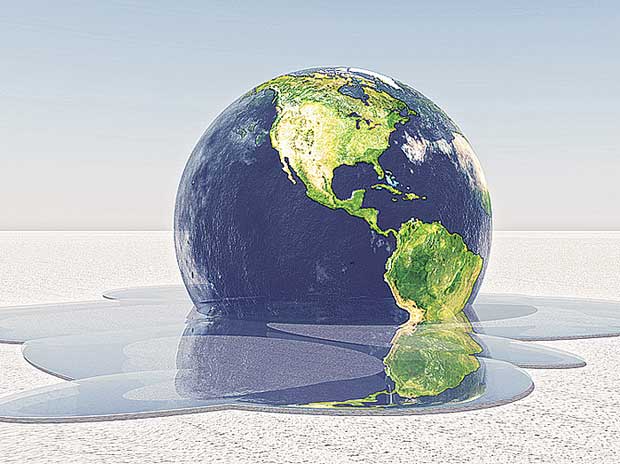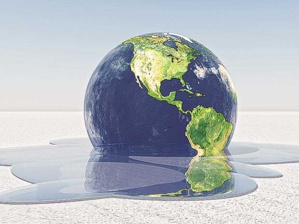According to a new study, the damaging consequences of climate change resulting in excessive carbon emissions is likely to increase and “persist for millennia” while the global energy strategy shows no such promise of coming up with a “dramatic new” move in the near future.
With every passing day the global temperature is rising causing glaciers and ice fields to melt, whereby the sea level is rising proportionately. Moreover, there are other such threats and that could ultimately submerge “coastal areas that are home to 1.3 billion people today”. According to Jeremy Shakun from the United States’ Boston College:
"What our analysis shows is that this era of global warming will be as big as the end of the Ice Age. And what we are seeing is a massive departure from the environmental stability civilisation has enjoyed during the last 10,000 years of its development”.
An “international team of researchers” conducted the study by creating “state-of-the-art climate and ice sheet models”, whereby they predicted “new scenarios” regarding the melting glaciers, the rising sea level, flooded coastal areas and increasing temperature on a global scale.
Their experiment involved a global output that was projected at “1,280 billion tonnes of carbon” in coming centuries, way under the ‘estimated reserves of at least 9,500 billion tonnes”.
However, even the project carbon emission levels show consequences wherein the “global average temperature” will exceed the “recognised 'guardrail' of two degrees Celsius”. Additionally, the melting of glaciers and ice sheets present at Antarctica and Greenland will cause a rise of twenty five meters in the sea-levels.
The study claims that the disappearing coastal areas will cause a displacement of almost “1.3 billion people” across the globe, accounting for more or less nineteen percent of the global population. Around twenty five mega cities from around the world can witness fifty percent of their population taking the brunt of the rising sea level, whereby being robbed off their home and business premises.
Furthermore, the report informed:
“The perspective on the future-looking projections comes from looking back at the last Ice Age, which ended approximately 10,000 years ago. Researchers developed a clearer portrait of that era of glacial melting and how the climate responded to and recovered from than era of significant climatic changes”.
Likewise, the researchers got to work by reconstructing “a record” that took into account “natural carbon emission, temperature rise, glacial melting and sea-level rise” and stretched the same data back to “20,000 years” marking the peak of previous Ice Age. Likewise, they created a “paleo-climatological portrait” that demonstrate that a rise of hundred thirty metres in sea-level took around “10,000 years to retreat”, allowing the climate to stabilise and human civilisation to flourish further. While, Shakun adds:
"This gives us the opportunity to provide the long view on global temperature and sea level rise, from the end of the Ice Age to today and then onward another 10,000 years into the future”.
Policy makers need to be alerted by the findings of the study as its projections disclose “the intractability of a climate change across millennia”.
References:
http://www.deccanchronicle.com/
With every passing day the global temperature is rising causing glaciers and ice fields to melt, whereby the sea level is rising proportionately. Moreover, there are other such threats and that could ultimately submerge “coastal areas that are home to 1.3 billion people today”. According to Jeremy Shakun from the United States’ Boston College:
"What our analysis shows is that this era of global warming will be as big as the end of the Ice Age. And what we are seeing is a massive departure from the environmental stability civilisation has enjoyed during the last 10,000 years of its development”.
An “international team of researchers” conducted the study by creating “state-of-the-art climate and ice sheet models”, whereby they predicted “new scenarios” regarding the melting glaciers, the rising sea level, flooded coastal areas and increasing temperature on a global scale.
Their experiment involved a global output that was projected at “1,280 billion tonnes of carbon” in coming centuries, way under the ‘estimated reserves of at least 9,500 billion tonnes”.
However, even the project carbon emission levels show consequences wherein the “global average temperature” will exceed the “recognised 'guardrail' of two degrees Celsius”. Additionally, the melting of glaciers and ice sheets present at Antarctica and Greenland will cause a rise of twenty five meters in the sea-levels.
The study claims that the disappearing coastal areas will cause a displacement of almost “1.3 billion people” across the globe, accounting for more or less nineteen percent of the global population. Around twenty five mega cities from around the world can witness fifty percent of their population taking the brunt of the rising sea level, whereby being robbed off their home and business premises.
Furthermore, the report informed:
“The perspective on the future-looking projections comes from looking back at the last Ice Age, which ended approximately 10,000 years ago. Researchers developed a clearer portrait of that era of glacial melting and how the climate responded to and recovered from than era of significant climatic changes”.
Likewise, the researchers got to work by reconstructing “a record” that took into account “natural carbon emission, temperature rise, glacial melting and sea-level rise” and stretched the same data back to “20,000 years” marking the peak of previous Ice Age. Likewise, they created a “paleo-climatological portrait” that demonstrate that a rise of hundred thirty metres in sea-level took around “10,000 years to retreat”, allowing the climate to stabilise and human civilisation to flourish further. While, Shakun adds:
"This gives us the opportunity to provide the long view on global temperature and sea level rise, from the end of the Ice Age to today and then onward another 10,000 years into the future”.
Policy makers need to be alerted by the findings of the study as its projections disclose “the intractability of a climate change across millennia”.
References:
http://www.deccanchronicle.com/






